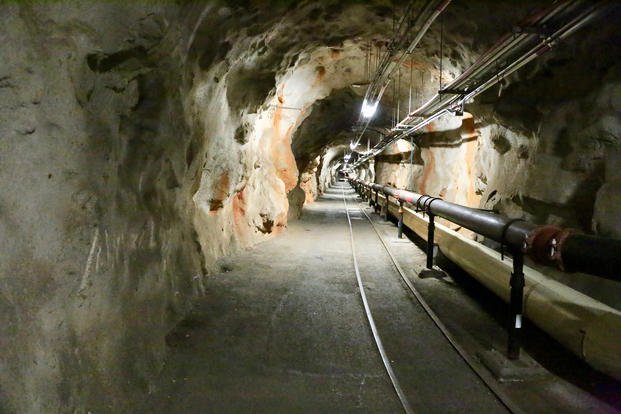Members of the Red Hill Community Representation Initiative are expressing frustration with federal officials who declined to attend a scheduled meeting for a second time.
Since the March community meeting, several new documents have emerged that CRI members say raise serious questions. The absence of officials calls pledges of transparency into question, they say.
The CRI, which met Thursday, was created as part of a federal consent order regarding the closure of Red Hill among the Environmental Protection Agency, state Department of Health and military. It is made up of a mixture of local residents and activists along with people directly affected by the Red Hill water crisis, which began in November 2021 when fuel from the Navy's bulk Red Hill fuel storage facility entered and contaminated the Navy's Oahu water system, which serves 93, 000 people.
Its formation came out of requests for community involvement in the defueling and shutdown process. The Red Hill facility sits just 100 feet above a critical aquifer most of Oahu relies on for drinking water.
A federal judge recently unsealed a whistleblower complaint by former Red Hill fuel director Shannon Bencs that alleged numerous failures on the part of Navy contractors to inspect and maintain the Red Hill facility. The complaint also included allegations of multiple prior, undisclosed leaks of "forever chemicals " at the Red Hill facility prior to the November 2021 fuel incident.
And last week the Pentagon's Inspector General released an audit of military fuel facilities concluding that a lack of oversight has left the majority of them "at an increased risk of fuel leaks and spills, which could endanger public health, harm natural resources, and lead to mission failure."
"How do we know that these incredibly poisonous 'forever chemicals' were actually cleaned up—is there any risk to neighborhoods and schools in ' Aiea and Moanalua, or wherever they took any contaminated materials ?" said CRI member Walter Chun. "These are critical questions that we need to ask, and that the Navy needs to answer—for our safety, and the safety of our children and future generations."
Several of the contractors named in the whistleblower complaint have made millions—if not billions—of dollars on maintenance contracts in Hawaii. However, despite all that has been spent on maintenance of the World War II-era facility, after the November 2021 incident Navy officials acknowledged Red Hill and the pipelines connecting it to Joint Base Pearl Harbor-Hickam had fallen into deep disrepair.
It took a joint military task force of experts from each military branch almost a year to fix and upgrade the facility and pipelines to make them safe enough to remove the more than 104 million gallons of fuel in the tanks. Now the newly formed Navy Closure Task Force Red Fill has taken over, removing residual sludge as it prepares to dismantle the pipelines and shutter the facility.
"If even half of these alleged facts are true, then Navy contractors were a huge part of the pattern of neglect that led to this crisis, " said CRI member Melodie Aduja. "Our understanding is that some of these contractors are continuing to do work for the ( Navy Closure Task Force ). What are they responsible for now ? Will independent experts be able to double-check their work ? The Navy needs to stop hiding so we can ask them these basic questions."
A review of military fuel facility contracts in Hawaii by the Honolulu Star-Advertiser in January 2022 found that the contractor that at that time had profited the most from working on the Navy's fuel systems in Hawaii was APTIM Federal Serv ices LLC out of Baton Rouge, La.—one of five companies named in Bencs' whistleblower complaint. According to publicly available data, the company and various subsidiaries received at least $106.5 million in contracts from the Navy for various maintenance, repair and alteration work on fuel facilities and pipelines in Hawaii between 2017 and 2021.
From the beginning, relations between the CRI and Navy officials have been tense. CRI members have accused Navy officials of dodging questions and lying at meetings. Navy officials have countered that CRI members have acted disrespectfully and acted outside of the scope of the consent decree. Navy officials have also stressed that the federal consent order only requires them to attend two meetings per quarter—though at some meetings senior officials expressed a willingness to meet more often.
Navy officials declined to attend a meeting in January, and in a statement to the Star-Advertiser, the Navy said that it "has not stopped participating in the CRI and remains fully committed to meeting the intent to the U.S. Environmental Protection Agency's 2023 consent order regarding the Community Representation Initiative (CRI ). Unfortunately, recent CRI actions have taken this initiative off course and driven the need for a reset in January."
The Navy attended the February CRI meeting, but prior to the March meeting put out a media release asserting that "following ( Navy ) and DLA efforts to consult with the EPA and the elected community representatives throughout January and early February, the CRI meeting held on Feb. 15 did not live up to the ( Navy )'s and DLA's enduring commitment to interact with stakeholders in a safe and respectful information sharing forum."
At the March meeting the EPA called on the Navy and CRI members to enter into mediation with an "EPA arranged mediator " with the Federal Mediation and Conciliation Service. The CRI has expressed skepticism of the proposal, and members have rejected requests by Navy officials for private meetings, so far insisting on keeping proceedings public.
"This is hard work—for all of us, " CRI Chair Marti Townsend said in a statement. "But it is work that we must do together—to give the public the transparency we deserve, to understand and heal the harm that has been done, and to protect the health and safety of our community and our future generations."
___
(c)2024 The Honolulu Star-Advertiser
Distributed by Tribune Content Agency, LLC.












